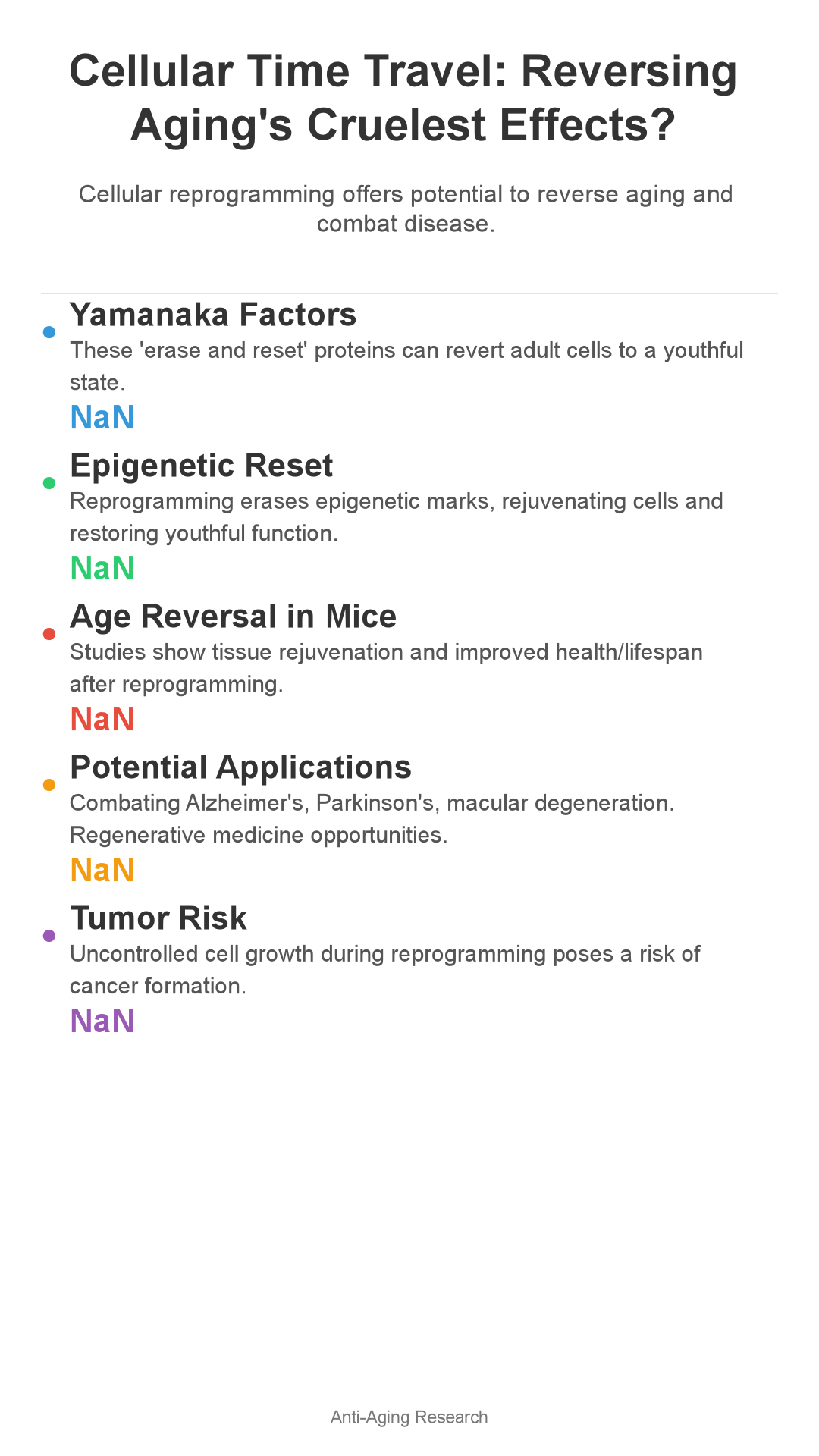
Is cellular "time travel" the key to reversing aging's cruelest effects? Dive into the fascinating w
Imagine turning back your body’s clock. Scientists are now exploring cellular “time travel” – reprogramming cells to undo age-related damage. Could this unlock longer, healthier lives, or does it open a Pandora’s Box of ethical dilemmas?
Hello, fellow explorers of the unknown! Are you ready to delve into the fascinating world of anti-aging research?
Today, we’re tackling a concept straight out of science fiction: cellular reprogramming, or as I like to call it, cellular “time travel.
The Science of Cellular Reprogramming: Turning Back the Clock
Picture this: a cell, aged and weary, suddenly gets a brand-new beginning. That’s the promise of cellular reprogramming.
This process involves taking a specialized cell, like a skin cell, and transforming it back into a pluripotent stem cell – a blank slate capable of developing into any cell type in the body.
Yamanaka Factors: The Discovery and Function
The heroes of this story are the Yamanaka factors, named after the brilliant Japanese scientist Shinya Yamanaka, who was awarded the Nobel Prize for their groundbreaking discovery.
These are a set of transcription factors – proteins that regulate gene expression – that can induce pluripotency in adult cells. Think of them as the “erase and reset” buttons for a cell’s identity.
How Reprogramming Works: Erasing Epigenetic Marks
But how do these factors actually work their magic? It all comes down to epigenetics – modifications to our DNA that influence gene activity without altering the DNA sequence itself.
As we age, our cells accumulate epigenetic marks that reflect their history and experience. Reprogramming essentially erases these marks, resetting the cell to a more youthful state.
Partial vs. Full Reprogramming: Benefits and Risks
Now, here’s where it gets really interesting.
Scientists are exploring two primary approaches: full reprogramming, which completely resets the cell to a pluripotent state, and partial reprogramming, which rejuvenates the cell without fully erasing its identity.
Full reprogramming carries the risk of uncontrolled cell growth and potential tumor formation, while partial reprogramming may offer a safer, more targeted approach.
Reversing Age-Related Damage: Promising Results and Potential Applications
Alright, so we can turn back the clock on cells in a lab dish. But can we actually reverse the effects of aging in living beings? Surprisingly, the answer is yes – at least in animal studies.
Animal Studies: Age Reversal in Mice
Researchers have demonstrated that cellular reprogramming can rejuvenate tissues and organs in mice, leading to improvements in their overall health and lifespan.
For instance, studies have shown age reversal in the eyes of mice, restoring vision in animals suffering from age-related macular degeneration.
Other studies have revealed improvements in muscle function, kidney function, and even cognitive abilities in aged mice following reprogramming.
Addressing Age-Related Diseases: Alzheimer’s, Parkinson’s, and Macular Degeneration
The potential applications for human health are truly remarkable. Imagine using reprogramming to combat age-related diseases such as Alzheimer’s, Parkinson’s, and macular degeneration.
By rejuvenating cells in the brain or retina, we could potentially slow down or even reverse the progression of these devastating conditions.
Regenerative Medicine: Repairing Damaged Tissues and Organs
Beyond treating specific diseases, cellular reprogramming has the potential to revolutionize regenerative medicine.
Instead of relying on organ donors, we could potentially grow new tissues and organs from a patient’s own reprogrammed cells, eliminating the risk of immune rejection.
The Challenges and Risks of Cellular Reprogramming
Of course, this technology is not without its hurdles and potential dangers. We’re not quite ready to offer cellular “time travel” packages to the public just yet.
Tumor Formation: The Risk of Cancer
One of the primary concerns is the risk of tumor formation. Because reprogramming involves resetting cellular identity and encouraging cell growth, it carries the potential for uncontrolled cell proliferation and, consequently, cancer.
Immune Rejection: The Body’s Defenses
Another challenge lies in the possibility of immune rejection. Even when using a patient’s own cells for reprogramming, the reprogrammed cells might still be recognized as foreign by the immune system, leading to inflammation and rejection.
Delivery Methods and Specificity: Getting to the Right Place
Finally, we need to develop safe and effective methods for delivering reprogramming factors to the intended target cells. Viral vectors are commonly used to deliver genes into cells, but they can be associated with unwanted side effects.
Ethical Considerations and the Future of Aging
Beyond the scientific challenges, cellular reprogramming raises some profound ethical questions that society needs to address.
The Societal Impact: Resource Allocation and Inequality
If we can significantly extend human lifespan, what impact will this have on society? Will these treatments be accessible to everyone, or will they be limited to the wealthy elite, further exacerbating existing inequalities?
How will we allocate resources in a world where people are living much longer?
Defining “Successful” Aging: Healthspan vs. Lifespan
Perhaps the most fundamental question is what it truly means to age “successfully. ” Is the ultimate goal simply to live longer, or is it to live healthier and more fulfilling lives?
Should we prioritize extending lifespan or healthspan – the portion of life spent in good health? The ideal answer, of course, is both. We aspire to live longer, healthier lives, free from the debilitating effects of age-related diseases.
The Future of Research: Gene Editing and Small Molecules
The future of aging research is brimming with excitement.
Scientists are exploring innovative approaches to cellular rejuvenation, including gene editing technologies like CRISPR and small molecule interventions that can mimic the effects of reprogramming without the associated risks.
So, what do *you* think? Is cellular “time travel” a far-fetched fantasy, or a genuine possibility for the future of medicine? And more importantly, if we *could* reverse aging, *should* we? Share your thoughts in the comments below!
If you enjoyed this deep dive into the world of cellular reprogramming, be sure to hit that like button and subscribe for more wild facts, weird science, and internet rabbit holes!
And if you’re feeling extra generous, share this article with your friends.

Enjoyed this? Check out our YouTube channel for video versions!
Enjoyed this? Check out our YouTube channel for video versions!



